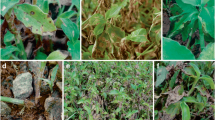Abstract
Weeds of the genus Orobanche are obligatory chlorophyll-lacking root parasites that infect and severely damage many dicotyledonous agricultural crops in warm-temperate and subtropical regions of the world. The genus comprises over 100 species, at least six of which are notable weeds. Orobanche palaestina Reut. is an endemic Mediterranean species, previously reported to parasitize thistles [Notobasis syriaca (L.) Cass. and Cirsium phyllocephalum Boiss. & Bl.] and annual legumes in native Mediterranean habitats, mainly in disturbed places such as roadsides and waste sites. In recent years, we have observed a rapid expansion of O. palaestina populations adjacent to commercial agricultural fields in the Jezreel Valley of Israel. The ability of O. palaestina to infect crops was tested in pots under nethouse conditions. The experiments revealed that O. palaestina is able to parasitize agricultural crops. Safflower (Carthamus tinctorius L.), lettuce (Lactuca sativa L.), gazania (Gazania uniflora Gaertn.), vetch (Vicia sativa L.) and artichoke (Cynara scolymus L.) were found to be potential hosts for this parasite, and all of them, except vetch and artichoke, were preferred to thistle, the native host. Sunflower (Helianthus annuus L.) induced O. palaestina seed germination and root attachment, but the attached parasites could not reach maturity and died soon after the attachment stage. Tomato (Lycopersicon esculentum Mill.), carrot (Daucus carota L.), garland chrysanthemum (Chrysanthemum coronarium L.) and cabbage (Brassica oleraceae L.) were not parasitized by O. palaestina.






Similar content being viewed by others
References
Bakheit, B. R., Allam, A. Y., & Galal, A. H. (2001). Intercropping faba bean with some legume crops for control of Orobanche crenata. Assiut Journal of Agricultural Sciences, 32, 1–9.
Bakheit, B. R., Allam, A. Y., & Galal, A. H. (2002). Intercropping faba bean with some legume crops for control of Orobanche crenata. Acta Agronomica Hungarica, 50, 1–6.
Córdoba, E., González-Verdejo, C. U., Die, J., Román, B., & Nadal, S. (2008). First report of Orobanche crenata on sulla (Hedysarum coronarium) in Andalusia, southern Spain. Plant Disease, 92, 1709.
Dor, E., Eizenberg, H., Joel, D. M., Levitin, E., & Hershenhorn, J. (2008). First report of Orobanche crenata parasitism on ornamental anemone (Anemone coronaria L.) in Israel. Plant Disease, 92, 655.
Feinbrun-Dothan, N. (1978). Flora Palaestina part three, Ericaceae to Compositae (pp. 214–215). Jerusalem, Israel: The Israel Academy of Sciences and Humanities.
Fernández-Aparicio, M., Emeran, A. A., Moral, A., & Rubiales, D. (2009). First report of crenate broomrape (Orobanche crenata) on white lupin (Lupinus albus) growing in alkaline soils, in Spain and Egypt. Plant Disease, 93, 970.
Hershenhorn, J., Eizenberg, H., Dor, E., Kapulnik, Y., & Goldwasser, Y. (2009). Broomrape management in tomato. Weed Research, 49, 34–47.
Joel, D. M., & Eisenberg, H. (2002). Three Orobanche species newly found on crops in Israel. Phytoparasitica, 30, 187–189.
Joel, D. M., Hershenhorn, J., Eizenberg, H., Aly, R., Ejeta, G., Rich, J. P., et al. (2007). Biology and management of weedy root parasites. Horticultural Reviews, 33, 267–350.
Kharrat, M., Halila, M. H., Linke, K. H., & Haddar, T. (1992). First report of Orobanche foetida Poiret on faba bean in Tunisia. FABIS Newsletter, 30, 46–47.
Parker, C., & Riches, C. R. (1993). Parasitic weeds of the world: biology and control (p. 111). Wallingford, UK: CAB International.
Prider, J., Correll, R., & Warren, P. (2012). A model for risk-based assessment of Phelipanche mutelii (branched broomrape) eradication in fields. Weed Research, 52, 526–534.
Rubiales, D., Fernádez-Aparici, M., & Rodríguez, M. J. (2008). First report of Orobanche crenata on lentil (Lens culinaris) and common vetch (Vicia sativa) in Salamanca province, Spain. Plant Disease, 92, 1368.
Rubiales, D., Sadiki, M., & Román, B. (2005). First report of Orobanche foetida on common vetch (Vicia sativa) in Morocco. Plant Disease, 89, 528.
Sauerborn, J., Muller-Stover, D., & Hershenhorn, J. (2007). The role of biological control in managing parasitic weeds. Crop Protection, 26, 246–254.
Acknowledgments
Contribution from the Agricultural Research Organization, The Volcani Center, Bet Dagan, Israel, No. 524/13.
Author information
Authors and Affiliations
Corresponding author
Rights and permissions
About this article
Cite this article
Dor, E., Eizenberg, H., Joel, D.M. et al. Orobanche palaestina: a potential threat to agricultural crops in Israel. Phytoparasitica 42, 285–291 (2014). https://doi.org/10.1007/s12600-013-0368-z
Received:
Accepted:
Published:
Issue Date:
DOI: https://doi.org/10.1007/s12600-013-0368-z




